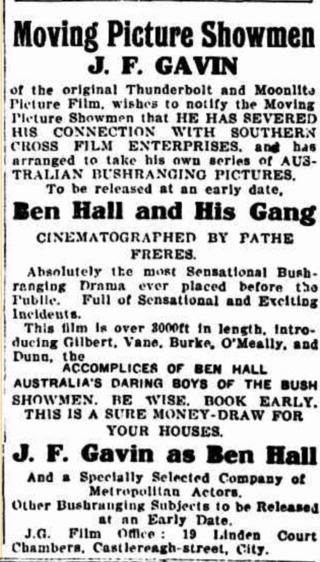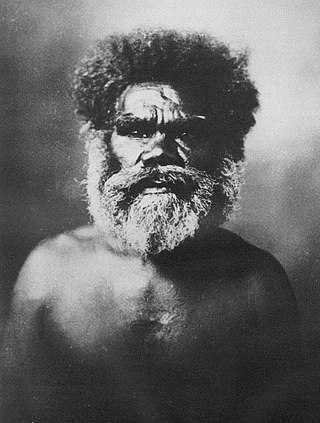
Johnny Gilbert was an Australian bushranger who was shot dead by the police at the age of 23 near Binalong, New South Wales on 13 May 1865.

Ben Hall was an Australian bushranger and leading member of the Gardiner–Hall gang. He and his associates carried out many raids across New South Wales, from Bathurst to Forbes, south to Gundagai and east to Goulburn. Unlike many bushrangers of the era, Hall was not directly responsible for any deaths, although several of his associates were. He was shot dead by police in May 1865 at Goobang Creek. The police claimed that they were acting under the protection of the Felons Apprehension Act 1865, which allowed any bushranger who had been specifically named under the terms of the Act to be shot, and killed by any person at any time without warning. At the time of Hall's death, the Act had not yet come into force, resulting in controversy over the legality of his killing.

Patrick Daley, known informally as 'Patsy' Daley, was a 19th-century Australian bushranger. Daley was the younger cousin of John O’Meally, a member of Frank Gardiner’s gang of bushrangers who robbed the gold escort near Eugowra in June 1862. By early 1863 Patsy Daley had joined with O’Meally and Ben Hall in a series of robberies carried out in the Young district. Daley was captured in March 1863 and sentenced to fifteen years hard labour. He was released in 1873. Daley married and settled in the Cobar district, becoming a successful businessman and hotel-owner.

Ben Hall and his Gang is a 1911 Australian film about the bushranger Ben Hall, played by John Gavin, who also directed. It is considered a lost film.
Robbery Under Arms is a 1907 Australian silent western/drama film based on the 1888 novel by Rolf Boldrewood about two brothers and their relationship with the bushranger Captain Starlight. It was the first film version of the novel and the third Australian feature ever made.
The Life and Adventures of John Vane, the Notorious Australian Bushranger is a 1910 Australian silent film about the bushranger John Vane, who was a member of Ben Hall's gang. It was the first dramatic film from Charles Cozens Spencer who was a key producer of early Australian movies.
A Tale of the Australian Bush is a 1911 Australian silent film directed by Gaston Mervale. Set in colonial Australia, it was also known as Ben Hall, the Notorious Bushranger and is considered a lost film.

The Squatter's Son is an Australian film completed in 1911 and directed by E. I. Cole. It was based on a play which Cole and his company had performed throughout Australia.

Sentenced for Life is an Australian film directed by E. I. Cole. It was an adaptation of a play performed by Cole and his Bohemian Dramatic Company as early as 1904.

Dan Morgan is a 1911 Australian film from Charles Cozens Spencer about the bushranger Daniel Morgan. It was said to be starring "Alfred Rolfe and company". Rolfe directed three movies for Spencer, all starring himself and his wife Lily Dampier so there is a chance he may have directed this one and that it starred his wife. A prospectus for the Australian Photo Play Company said he directed it. It is considered a lost film.
The Gardiner–Hall Gang was an informal group of bushrangers who roamed the central west of the Colony of New South Wales, Australia in the 1860s. Named after leaders Frank Gardiner and Ben Hall, the gang was involved in numerous shootouts and robberies, including Australia's largest ever gold robbery, at Eugowra Rocks. The gang had its origins in 1861; its demise came with the execution of John Dunn in 1866.

Patrick William Marony, known professionally as P. W. Marony, was an Australian painter, political cartoonist, photographer and writer. Marony's practice as an artist and a writer spanned the period of cultural transition from the popularity of history painting to the emergence of cinematic versions of history. He painted a series of bushranger-themed works which were exhibited in the mid-1890s. Marony wrote several film scripts for the Australian Life Biograph Company. Twenty-six of his oil paintings, mostly of bushrangers, are a part of the collection of the National Library of Australia.

John Vane was an Australian bushranger who joined with the John Gilbert's gang for a short period during 1863. He rode with Gilbert, Ben Hall, John O’Meally and his friend Mick Burke, all of whom eventually met violent deaths. Burke, who had been Vane's childhood friend, died in a violent gun-fight at 'Dunn's Plains', near Rockley. Vane managed to avoid the fate of his companions when he gave himself up. In 1905 Vane collaborated with author and newspaper editor, Charles White, in recording his recollections of the period he spent as part of the bushranging gangs led by Gilbert, Hall and O’Meally. Vane’s biography, edited by White, was published in 1908.

Edward Irham Cole was an Australian theatrical entrepreneur and film director whose productions represented a synthesis of Wild West show and stage melodrama. He managed a theatre company, called the Bohemian Dramatic Company, that performed in semi-permanent and temporary tent theatres. During 1910 and 1911 Cole directed a number of silent films, adapted from his stage plays and using actors from his theatre company.

Charles White, was an Australian journalist, author and historian, notable for his books on bushranging and other aspects of Australian history.

John O'Meally, known informally as 'Jack' O'Meally, was an Australia bushranger. He was recruited to join the Gardiner–Hall gang to carry out the gold escort robbery near Eugowra in June 1862, Australia's largest gold theft. O'Meally became a member of the group of bushrangers led by Johnny Gilbert and Ben Hall, which committed many robberies in the central west of New South Wales. Considered to be the most violent and hot-headed of the group, O'Meally was probably responsible for two murders during this time. The gang managed to evade the police for long periods and became the most notorious of the bushranging gangs of the 1860s. Jack O'Meally was shot and killed during an attack on the 'Goimbla' station homestead in November 1863.

Mulga Fred Wilson (c. 1874 – 2 November 1948) was an Australian Aboriginal stockman and buck-jump rider, known as Mulga Fred. He was the star attraction of various touring rodeo shows in the decade before the First World War. Wilson is considered to be the first Aboriginal actor to appear in a motion picture for his role in the film Bushranger's Ransom, or A Ride for Life, completed in 1911. By the 1920s Wilson was leading an itinerant lifestyle, mainly throughout the western districts of Victoria, with occasional visits to the urban centres of Melbourne and Geelong. He was a well-known character in western Victoria where he attended agricultural shows and football games, demonstrating his skills with the stockwhip and the boomerang, as well as his abilities as a buck-jump rider. He also worked as a horse-breaker and station-hand throughout his life. Mulga Fred died in November 1948 at Horsham railway station, aged about 74 years, from injuries received when he was hit by a train.
Caloola is a locality in the Central West region of New South Wales. There once was a small village of the same name but it is a ghost town today. At the 2016 census, the locality had a population of 88.
The King of the Road is a 1900 Australian play performed by Edward Irham Cole performed by Cole's Bohemian Drama Company about the bushranger Ben Hall.
Hands Up is a 1893 Australian play by George Leitch. The play was specifically devised to be a vehicle for Mrs Keightley, the wife of a gold commissioner at Bathurst, who was robbed by Ben Hall the bushranger. Keightley played herself The Mercury said it was "especially composed and arranged for her, containing many incidents not merely probably but absolutely true."













